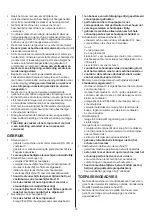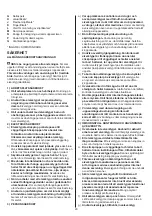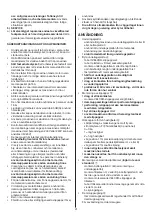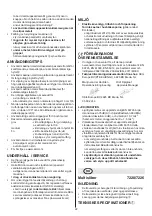
7
any adjustments, changing accessories, or storing
power tools.
Such preventive safety measures reduce
the risk of starting the power tool accidentally.
d)
Store idle power tools out of the reach of children
and do not allow persons unfamiliar with the power
tool or these instructions to operate the power tool.
Power tools are dangerous in the hands of untrained
users.
e)
Maintain power tools. Check for misalignment or
binding of moving parts, breakage of parts and any
other condition that may affect the power tool's
operation. If damaged, have the power tool repaired
before use.
Many accidents are caused by poorly
maintained power tools.
f)
Keep cutting tools sharp and clean.
Properly
maintained cutting tools with sharp cutting edges are
less likely to bind and are easier to control.
g)
Use the power tool, accessories and tool bits etc.,
in accordance with these instructions, taking into
account the working conditions and the work to
be performed.
Use of the power tool for operations
different from those intended could result in a hazardous
situation.
5) SERVICE
a)
Have your power tool serviced by a qualified repair
person using only identical replacement parts.
This will ensure that the safety of the power tool is
maintained.
SAFETY INSTRUCTIONS FOR SANDERS
•
Avoid damage that can be caused by screws, nails and
other elements in your workpiece; remove them before
you start working
•
Always keep the cord away from moving parts of the
tool; direct the cord to the rear, away from the tool
•
Secure the workpiece
(a workpiece clamped with
clamping devices or in a vice is held more securely than
by hand)
•
When you put away the tool, switch off the motor and
ensure that all moving parts have come to a complete
standstill
•
Use completely unrolled and safe extension cords with a
capacity of 16 Amps (U.K. 13 Amps)
•
In case of electrical or mechanical malfunction,
immediately switch off the tool and disconnect the plug
•
SKIL can assure flawless functioning of the tool only
when original accessories are used
•
This tool should not be used by people under the age
of 16 years
•
The noise level when working can exceed 85 dB(A);
wear ear protection
•
If the cord is damaged or cut through while working, do
not touch the cord, but immediately disconnect the plug
•
Never use the tool when cord is damaged; have it
replaced by a qualified person
•
Always check that the supply voltage is the same as
the voltage indicated on the nameplate of the tool (tools
with a rating of 230V or 240V can also be connected to
a 220V supply)
•
This tool is not suitable for wet sanding
• Do not work materials containing asbestos
(asbestos is considered carcinogenic)
•
Dust from material such as paint containing lead, some
wood species, minerals and metal may be harmful
(contact with or inhalation of the dust may cause allergic
reactions and/or respiratory diseases to the operator or
bystanders);
wear a dust mask and work with a dust
extraction device when connectable
•
Certain kinds of dust are classified as carcinogenic
(such as oak and beech dust) especially in conjunction
with additives for wood conditioning;
wear a dust
mask and work with a dust extraction device when
connectable
•
Follow the dust-related national requirements for the
materials you want to work with
•
When sanding metal, sparks are generated; do not use
dustbox/vacuum cleaner and keep other persons and
combustible material from work area
•
Do not touch the moving sanding sheet
•
Do not continue to use worn, torn or heavily clogged
sanding sheets
•
Wear protective gloves, safety glasses, close-fitting
clothes and hair protection (for long hair)
• Always disconnect plug from power source before
making any adjustment or changing any accessory
WHEN CONNECTING NEW 3-PIN PLUG (U.K. ONLY):
•
Do not connect the blue (= neutral) or brown (= live) wire
in the cord of this tool to the earth terminal of the plug
•
If for any reason the old plug is cut off the cord of
this tool, it must be disposed of safely and not left
unattended
USE
•
Backing pads
-
never run the tool without backing pad A or B, or
baseplate C
-
use the correct backing pad for the corresponding
application (see Application Advice)
!
replace damaged backing pads immediately
•
Changing backing pads
④
-
remove VELCRO sanding sheet
-
remove pad screw D with hex key E
-
mount backing pad A or B as illustrated
-
if necessary, clean backing pad first
-
fasten pad screw D with hex key E
!
hold backing pad firmly while loosening/fastening
pad screw D
!
unplug tool before removing/mounting backing
pads
!
pad screw D becomes hot during use; do not
touch it before it has cooled down
•
Mounting of sanding sheet
⑤
!
disconnect the plug
-
mount VELCRO sanding sheet as illustrated
!
the dust suction requires the use of perforated
sanding sheets
!
perforation in sanding sheet should correspond
with perforation in sanding foot
!
replace worn sanding sheets in time
!
always use the tool with the total sanding surface
covered with sanding paper
•
Two-speed switch
⑥
-
switch on/off the tool by pushing switch F
②
forward/
backwards (3 positions)
0 = off
1 = low speed
2 = high speed
Summary of Contents for 7220
Page 3: ...3 B E A D C L NOT STANDARD INCLUDED H K J ...
Page 4: ...4 M N P ...
Page 5: ...5 ACCESSORIES WWW SKIL COM G a b 120 ...
Page 108: ...108 COM SKIL WWW G 12 13 14 15 امللحقات ...
Page 109: ...109 M N P 8 9 10 11 ...
Page 110: ...110 B E A D C L H K J 4 5 7 6 3 ا ً ي قياس يتوفر ال الجهاز مع ...








































